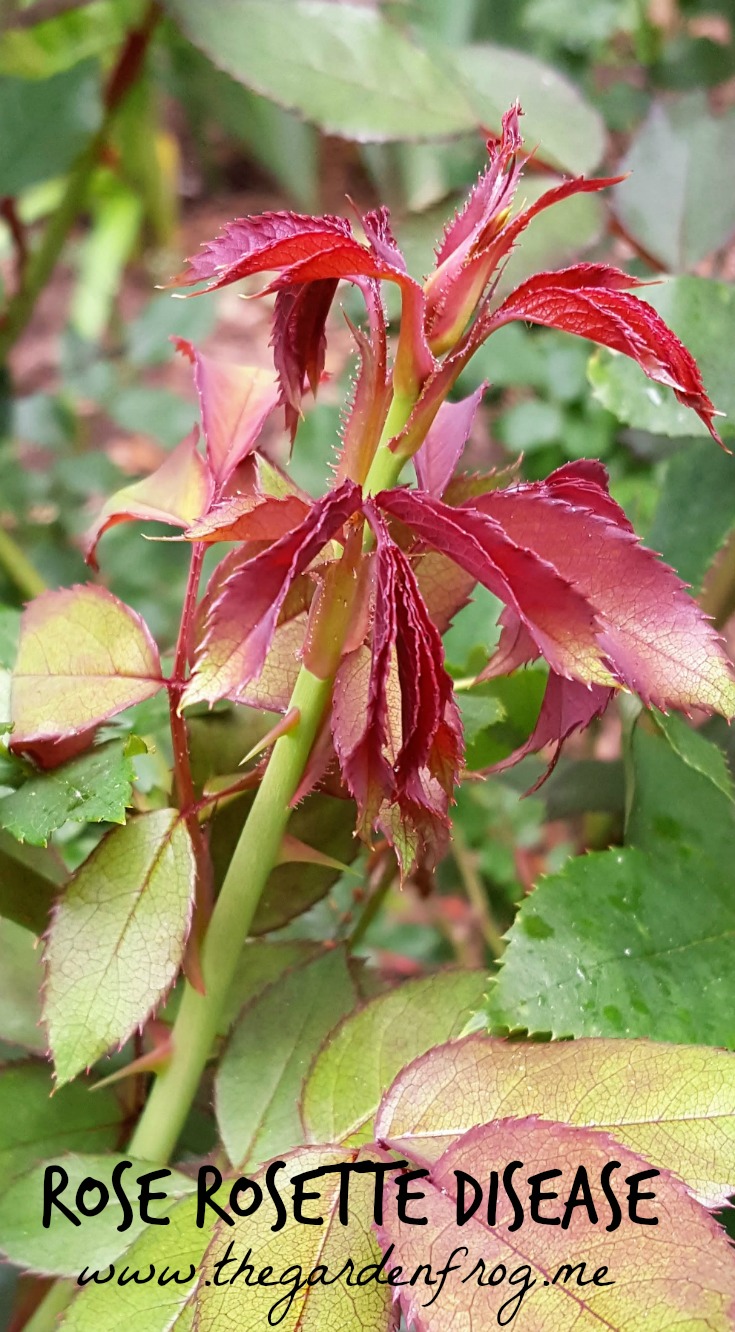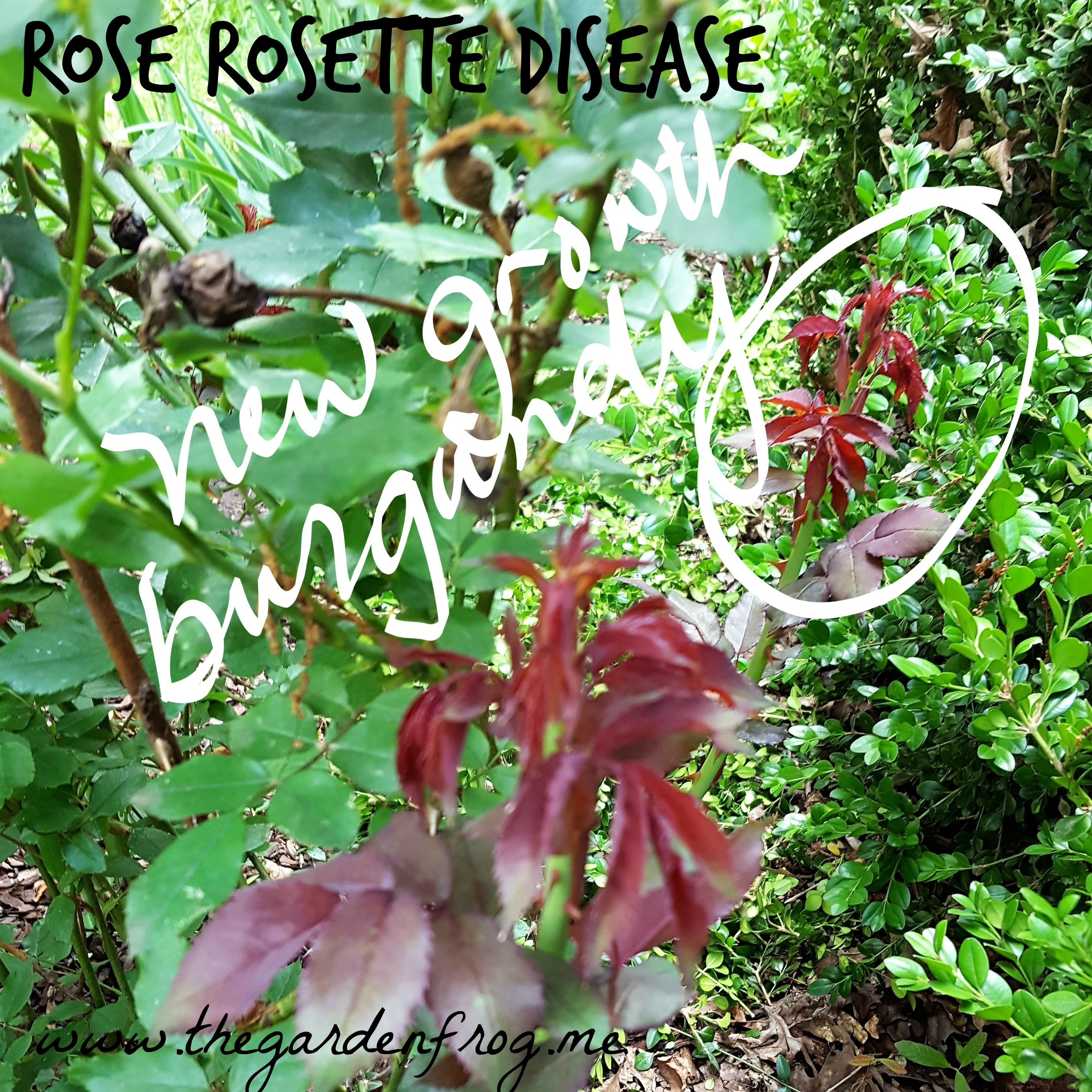 Rose Rosette disease in the Knockout Rose is very common viral disease here in SE Virginia now (and I know it is common in other states as well). It is a disease that affects many other roses such as the multifloral, climbing, and even hybrid roses. I have had first hand experience with this rose disease and its spread and I can tell you – THERE IS NO CURE OR SAVING THE PLANTS.
Rose Rosette disease in the Knockout Rose is very common viral disease here in SE Virginia now (and I know it is common in other states as well). It is a disease that affects many other roses such as the multifloral, climbing, and even hybrid roses. I have had first hand experience with this rose disease and its spread and I can tell you – THERE IS NO CURE OR SAVING THE PLANTS.
I tried. Many young roses will die within a season or two. My climbing rose started to decline rapidly and the rose buds shriveled up as the disease took over. Knockouts, however, will live for at least 3-4 years blooming and growing and displaying the beautiful burgundy new growth and witches broom (thorns).
I dug up and removed the diseases roses, however, I have neighbors who refuse to remove their diseases Knockouts because they still grow and bloom. I tried to explain to them that this disease affects the soil and is transmitted to other roses in the vicinity and not just in their yard. What you are going to be shocked at is that a few of these homeowners received them FREE from our Homeowners Association and the maintenance team who was digging them up because I had told them months before the roses were diseased!
Ironic, huh?
The supervisor or manager of the maintenance team has been a landscaper for years and he and I have butted heads. I simply tell him I am not a landscaper – I am a naturescaper and I work with nature. I no longer go to my Homeowners Association or to the maintenance department any more because they do not care that the deer eat the native plants to survive, that Round UP should not be sprayed in native areas, and that diseased roses and plants should not be given away!
Oh shoot I digressed, sorry.
In these videos, I share with you what to look for and how to spot Rose Rosette disease. Knockouts are very hardy plants and even when consumed by this disease they will bloom and grow. The new growth of deep burgundy on Knockouts is gorgeous but it is deadly to other roses and to the soil. Wherever the diseased roses grow, the soil is no longer viable for roses in the future. So you will have to find a new location for any rose bushes in the future.
If you Google Rose Rosette Disease you will find information about the very small Eriophyid Mite that spreads this viral disease. This disease can wipe out a row of roses in one season so if you see the signs early you may be able to save other roses before it spreads. The female Eriophyid mites will be hard to see and they hide near new growth shoots and in the bud at the end of the stem (or terminal bud/apex) where they lay one egg per day for a month. It is interesting to note that the male Eriophyid mites do not have wings but are carried throughout the garden by the wind, garden tools, and even your clothes.
You can use organic horticultural oils and insecticidal soaps in May- July on non affected roses to try and stop the spread. However, once a rose has the disease you must take immediate action to removed them and dispose of them properly (as seen in this video) 
A tip if you want to grow roses, do not plant them too close together. This can be a precaution to help you keep Rose Rosette disease from spreading in the garden.
Good luck and I hope this post help. I know it is sad when you have to dig up and destroy a plant. However, it must be done to avoid any future spread and destruction of nature’s beauty. Thanks for stopping by!
Creating. Inspiring. Gardening without the rules!
2017 copyrighted material C Renee




Thanks for this information. My landscaper tells me my roses are fine. We will see I guess.
Just keep watching! I hope yours do not get affected because you can never plant again in the same spot.
Although there are naysayers, I cut away any suspicious witches brew (usually shows up in July and August in zone 7B/8A in Ga) and sprayed hydrogen peroxide directly on plant and soil which seemed to help. Also was told by main nursery here to fertilize in spring will help plants be stronger. Fighting it for 5 years now. Some I threw out, some survived and are actually thriving, even the Drifts. Planting @ least 3 ft apart helped I think. Now I am even more determined to keep my favorite flower; Canna, healthy and virus-free. One-way; if Canna looks bad, try cutting it to the ground before you throw it out; it will usually be much healthier with the 2nd growth! I just don’t believe that plant diseases/viruses cannot be “cured”. They are now curing folks in the hospital that get Sepsis with intravenous Vitamin C… there is a cure for everything, just have to keep trying various things and find it 🙂
Hi Jan. I am glad you had success. I tried for 3 years to “cure” the knockouts and the disease progressed worse. It is a viral disease that affects the soil and it does spread and can quickly wipe out other roses in the vicinity. In an area where I live where people are not gardeners nor are they aware of diseases and other problems, it is best not to let a diseased plant live and possibly infect the whole neighborhood. This is just my opinion after seeing how fast the disease spread in our subdivision landscaping of over 50 knockouts. Thanks for your input and happy gardening
I certainly appreciate Renee! One thing I noticed with mine anyway was that the red knock-outs and drifts seemed to fair the worst; have gotten rid of 8 so far. All 3 of my yellow (sunny) ones have had no signs of the disease at all, and I have 2 light pink (blush) and a pink still okay also. I keep them all now planted separately except for some of the drifts I have in 3 different pots around 2 ft apart which are doing surprisingly well. I have 5 other various drifts still in the ground that are okay so far, but of course not holding my breath. BTW: Did you try just spraying some dish soap/H2O mixture or dusting flour or Seven dust on them?
FYI: I found this online: It had long been thought that the culprit was a virus, but other organisms such as phytoplasmas had also been considered. That changed in 2011 when researchers at the University of Arkansas and Oregon State University published their findings.
An extremely tiny (1/100 of an inch long and 1/400 of inch wide) eriophyid mite, Phyllocoptes fructiphilus, spreads the virus from plant to plant. They typically feed on shoot tips and at the bases of leaf stems (petioles). These mites are wingless, and are blown from plant to plant by the wind. The virus is also spread when infected (but asymptomatic) roses are grafted to propagate named varieties of roses.
Rose rosette disease is systemic and has been found in all parts of infected plants except for the seeds. The causal agent is not soil-borne, so roses can be successfully replanted where infested roses have been removed. However, removal must be very thorough so that no pieces of infected root are left behind that could re-sprout.
Controlling the mites is not as easy as it sounds; they are active from May through September, they are not visible to the naked eye, and they reproduce very rapidly, especially during hot, dry weather.
Because they are not insects, traditional insecticides that home gardeners use may not control them. What’s more, those insecticides can kill beneficial insects that keep other rose pests in check, so you can wind up with an outbreak of another pest.
Monitoring your roses carefully and getting rid of any that show suspicious growth is the most practical course of action.
Hi Jan. Yes I read about the disease and it is amazing how one little tiny mite can cause so much disease. I did try natural and kept spraying them with soap and water, natural, and then sevin and other chemicals with no relief. I do not like to spray because as you state these chemicals are also bad for the good insects. So I chose after 3 years to dispose of them in the garbage. Good luck with yours and I hope you can keep the disease in check.
That rose rosette is all throughout my neighborhood. It has destroyed ALL my roses over 60. It could have been prevented if the neighbors dug up their diseased roses. They refused. It would appear as if they didn’t believe me, or care or maybe just hate me and wanted to kill all my roses. I made up flyers passed them around door to door, put an article in the newspaper, got the local cooperative to give a class, but less than 10 people in the whole county showed up. I had some rare roses that can’t be replaced that I lost, all so my neighbors can grow diseased knockouts they purchased from the local big box store. I can’t wait until all those diseased monsters die. Here is a link to the most up to date researchers. When there is news they post it. Now I can hardly bear to grow flowers at all.
https://www.facebook.com/CombatingRoseRosette/
I am so sorry for your beloved roses. I do know what it is like to lose flowers that mean so much. Thanks for the sharing the newest info on the disease. And thank you for writing about your experience. Do not give up on gardening and I hope that one day the sadness wears off and you can find love in flowers again.